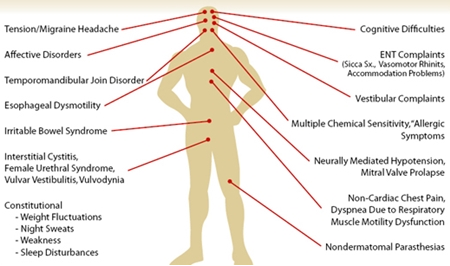 |
| 7 Common Types Of Fibromyalgia Pain |
Body pain is a fairly common
condition that occurs in many people around the world. This type of pain may be
felt in all parts of the body. However, pain that occurs without a clear reason
should alert you. Pain that affects any part of the body for no reason may be
the first sign of a condition called fibromyalgia.
What Is Fibromyalgia?
Fibromyalgia is a chronic pain
syndrome that may appear in any part of your body. It is often accompanied by
sleep, memory, and mood disorders. Fibromyalgia causes painful sensations by
affecting the process of how your brain perceives pain signals. Symptoms may
begin after injury, infection, surgery, or severe
mental stress. Sometimes, symptoms appear without a clear reason. Women are
more prone to fibromyalgia than men.
There is no treatment for
fibromyalgia. However, certain medications can help regulate and relieve its
symptoms. Stress-reduction measures also may help reduce the severity of
fibromyalgia symptoms.
Types Of Fibromyalgia Pain
1. Hyperalgesia
Hyperalgesia is an increased
sensitivity to pain. Things that will not hurt others will be extremely painful
for a person with hyperalgesia. Our brains get pain signals from nerve endings
that regulate its severity. If the brain is told that the pain is severe- then
it will be. In people with hyperalgesia, the brain makes the pain worse than it
would normally be.
Medications may slightly reduce
the pain but not always. In some patients increased doses of painkillers can
make the pain even worse.
2. Muscle Pain
This type of pain appears all
over the body and may be similar to flu. It is a permanent muscle and soft
tissue pain that is usually reported as gnawing soreness, stiffness, aching, or
throbbing all over the body. While this pain may affect any part of the body, it
is most likely to appear in the legs, arms, shoulders, and neck.
At the early stages of the
disease, the patient may feel pain only in one specific area. For example, neck
pain over time may spread to shoulders, arms, or upper back.
3. Abdominal Pain
About half of people with
fibromyalgia experience irritable bowel syndrome, bloating, and abdominal pain.
However, patients also report constipation, diarrhea, and nausea. Another
common problem in people with fibromyalgia is acid reflux. Sometimes, fibromyalgia
causes bladder discomfort and pain. Pelvic pain in patients with fibromyalgia
may also be associated with symptoms of intestinal cystitis.
4. Migraines And Headaches
Headaches are common for people
with fibromyalgia. Patients often experience tension headaches and describe it
as dull tightening pressure sensation all around the head. Migraines are more
painful and often occur in the side of the head. Some patients with migraines
also report migraine aura (vision changes like seeing flashing lights) and
sensitivity to light or sounds.
5. Allodynia
Allodynia is a condition when the
pain caused by things that normally don’t cause pain. Even mild pressure from
clothing or massage may cause pain. Such sensitivity to pain may result from
the central sensitization associated with FMS. Patients report this pain as
skin sensitivity that is comparable to a sunburn.
6. Neuropathic Pain
Neuropathic pain causes
sensations like crawling, numbness, burning, or tingling in the arms and legs.
Sometimes patients may feel painful sensations. This condition is often caused
by altered neurological function in the spinal cord and brain. However,
neuropathic pain also may result from a malfunction of the central inhibitory
process of pain control.
7. Joint Pain
Swelling and joint pain is common
in people with fibromyalgia. Patients often feel pain at the temporomandibular
joint. This joint connects your skull and jaw. Temporomandibular joint pain is
reported as a dull ache that spreads in the ear, temple, eyes, lower jaw, and
neck areas.
